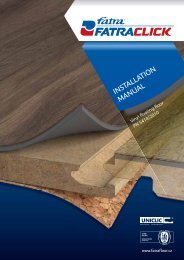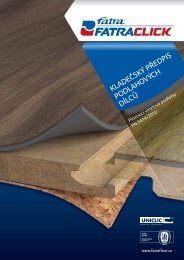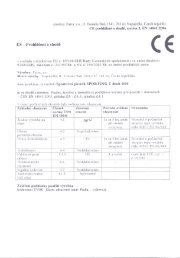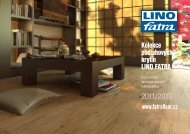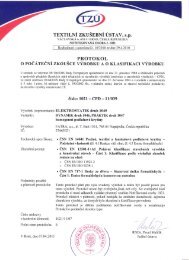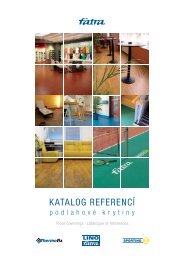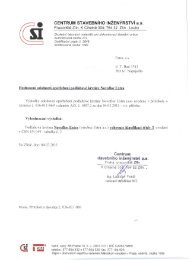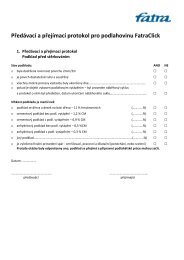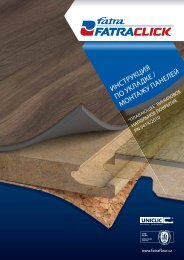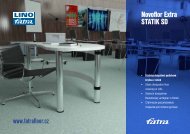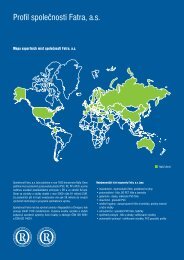Installation Manual - Fatra
Installation Manual - Fatra
Installation Manual - Fatra
Create successful ePaper yourself
Turn your PDF publications into a flip-book with our unique Google optimized e-Paper software.
15.1 Organic substances<br />
TYPE OF CHEMICAL EFFECT REMEDY<br />
Aldehydes<br />
Esters<br />
Halogen hydrocarbons<br />
Ketones<br />
Alcohols<br />
Ethers<br />
Glycols<br />
Hydrocarbons<br />
(aromatic and aliphatic)<br />
Paraffin<br />
Edible oil<br />
15.2 Water solutions<br />
The floor covering is attacked after<br />
several minutes<br />
Release of plasticizers occurs after a<br />
few days, accompanied by material<br />
shrinkage and embrittelment<br />
TYPE OF CHEMICAL EFFECT REMEDY<br />
Mild acids and alkalis No effect<br />
Strong alkalis<br />
Shine damaged, may cause some<br />
colours to fade<br />
Strong acids Protracted contact may cause colours<br />
to fade<br />
Wipe the floor immediately<br />
Wipe the floor immediately<br />
Dilute and remove<br />
Dilute and remove immediately<br />
Colouring agents (indicative) Contact may cause colours to fade Dilute and remove immediately<br />
Note: resistance to chemicals is tested for 24 hours while the product is in contact with the chemical at a<br />
room temperature of 21°C. The product is then washed with cold water. Some stains may be ground off<br />
with a nylon cube.<br />
16. HETEROGENEOUS PVC WALL COVERINGS<br />
16.1 Product details<br />
Heterogeneous PVC wall coverings consist of a wear layer and a base layer and are manufactured in 1,500 mm wide and 1.15<br />
mm thick strips. The coverings contain a PUR protective layer that makes cleaning easier, reduces maintenance costs and<br />
ensures resistance to microorganisms. Please see the relevant technical sheet and catalogue lists for specific technical<br />
parameters.<br />
16.2 Preparing the base<br />
In general, the bases where PVC wall coverings are to be applied must meet requirements similar to those for the installation of<br />
floor coverings (see section 3). The base must be level, smooth, free of cracks and dust and sufficiently firm, clean and dry.<br />
Grease stains and other impurities must be removed. Walls coated with oil paints must be scraped. Unevenness, cracks, joints<br />
and different levels must be repaired or levelled.<br />
The residual moisture of the base prepared for installation must not exceed 2.1% CM and 0.5% CM for cement and gypsum<br />
bases respectively (CM = carbide method). Wall coverings must not be installed in rooms that are not sufficiently insulated<br />
against moisture.<br />
16.3 Preparing the covering<br />
After a delivery inspection (see section 6), first unwind the covering and visually check the quality of its appearance and pattern.<br />
Do not install (bond) any wall covering with visible defects. Instead file a warranty claim with your supplier.<br />
Before installation, the unwound wall covering must be kept for at least 24 hours, or preferably 48 hours, in the room where it is<br />
to be installed. The product dimensions will stabilise and minor ripples will smooth out automatically during this time. The room<br />
temperature must not drop below +18°C during installation.



